Running a restaurant today means managing much more than food and service. Guests discover, judge, and connect with brands long before they walk through the door and often long after they’ve left. From making sure your hours are accurate on Google Maps, to replying to reviews, to sending timely offers or handling questions on social channels, every touchpoint shapes the guest experience.
That’s where guest experience platforms come in. These tools promise to simplify the complex job of managing online presence, engaging customers, and turning feedback into loyalty. But with so many platforms competing for attention, how do they really compare? We’ve broken down the major players across the features that matter most—so restaurant operators can see what’s hype, what’s helpful, and which solutions truly deliver.
1. Listings Management
Momos
Momos offers only the basics when it comes to listings management. Restaurants can push their core business information—name, address, and phone number—out to a limited set of providers. However, it stops short of more advanced functionality. There’s no ability to resolve conflicts if external platforms overwrite details, and important enhancements such as uploading photos, setting holiday hours, or adding richer attributes aren’t supported. This makes the feature more of a broadcast tool but limited for serious reputation or presence management.
Rating: ⭐⭐⭐ (3/5)
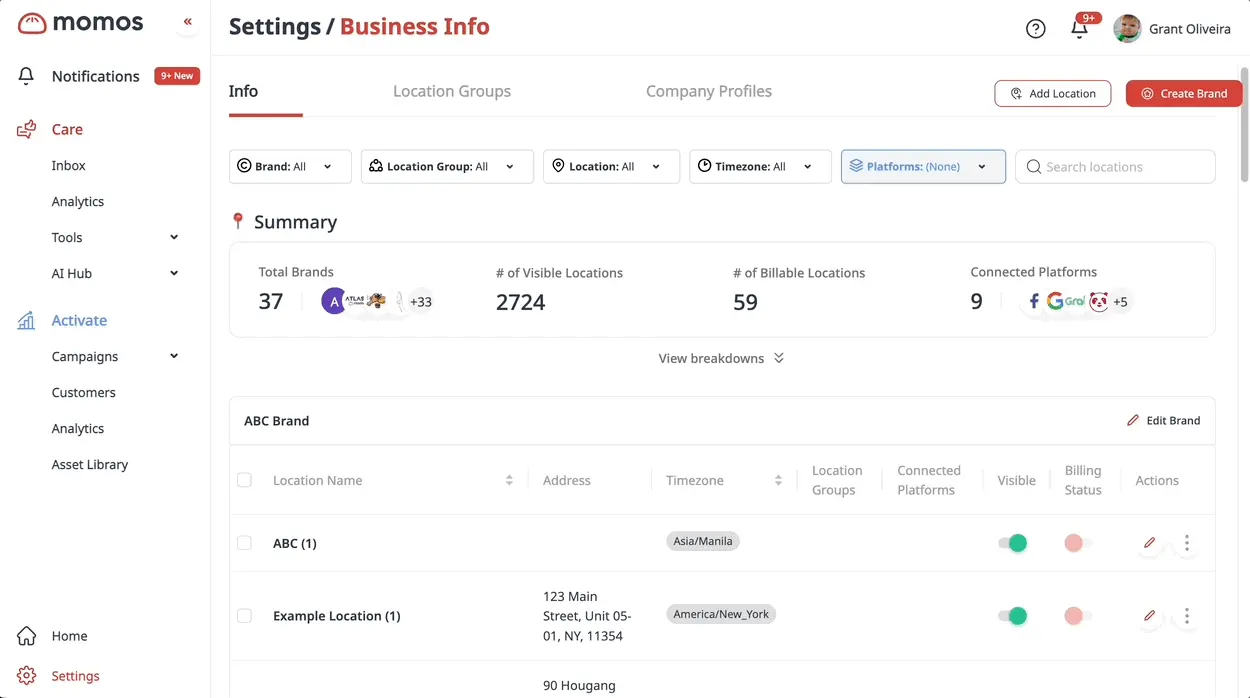
Ovation
Ovation skips listings management entirely. Restaurants using the platform need to handle their presence on Google, Apple, Yelp, and other directories with an additional tool.
Rating: (0/5)
Marqii
Marqii takes a comprehensive approach through direct integrations and a partnership with Yext. This gives restaurants visibility across 50+ platforms, ensuring consistency wherever customers search. The Yext partnership, however, comes with strings attached—discontinuing service can mean losing those listings, which creates a lock-in effect. Still, for restaurants seeking scale and automation, Marqii provides valuable extras, like a menu builder that syncs with Yelp and Google Maps.
Rating: ⭐⭐⭐⭐⭐ (5/5)
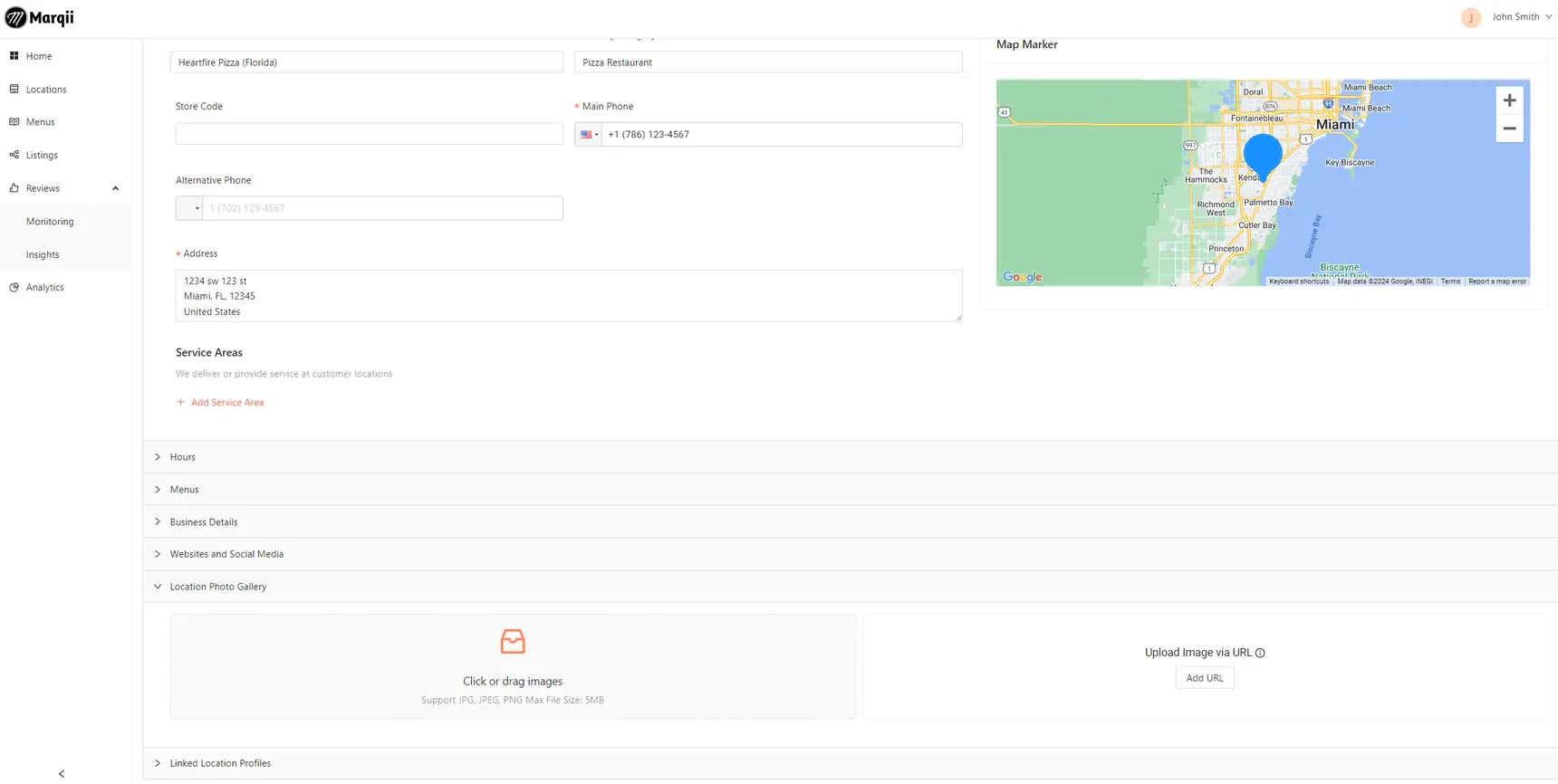
Pluspoint
Pluspoint combines broad reach with granular control. Restaurants can manage listings across 50+ platforms, including specialized food and travel directories such as Uber Eats and Tripadvisor. Its two-way integrations with Google, Apple, and Facebook mean conflicts and third-party edits can be monitored and resolved instantly. Its standout features are one-click photo uploads directly to Google Maps and the ability to flag unwanted photos for removal. This makes Pluspoint not just a distribution tool but a true control center for online presence.
Rating: ⭐⭐⭐⭐ (4/5)
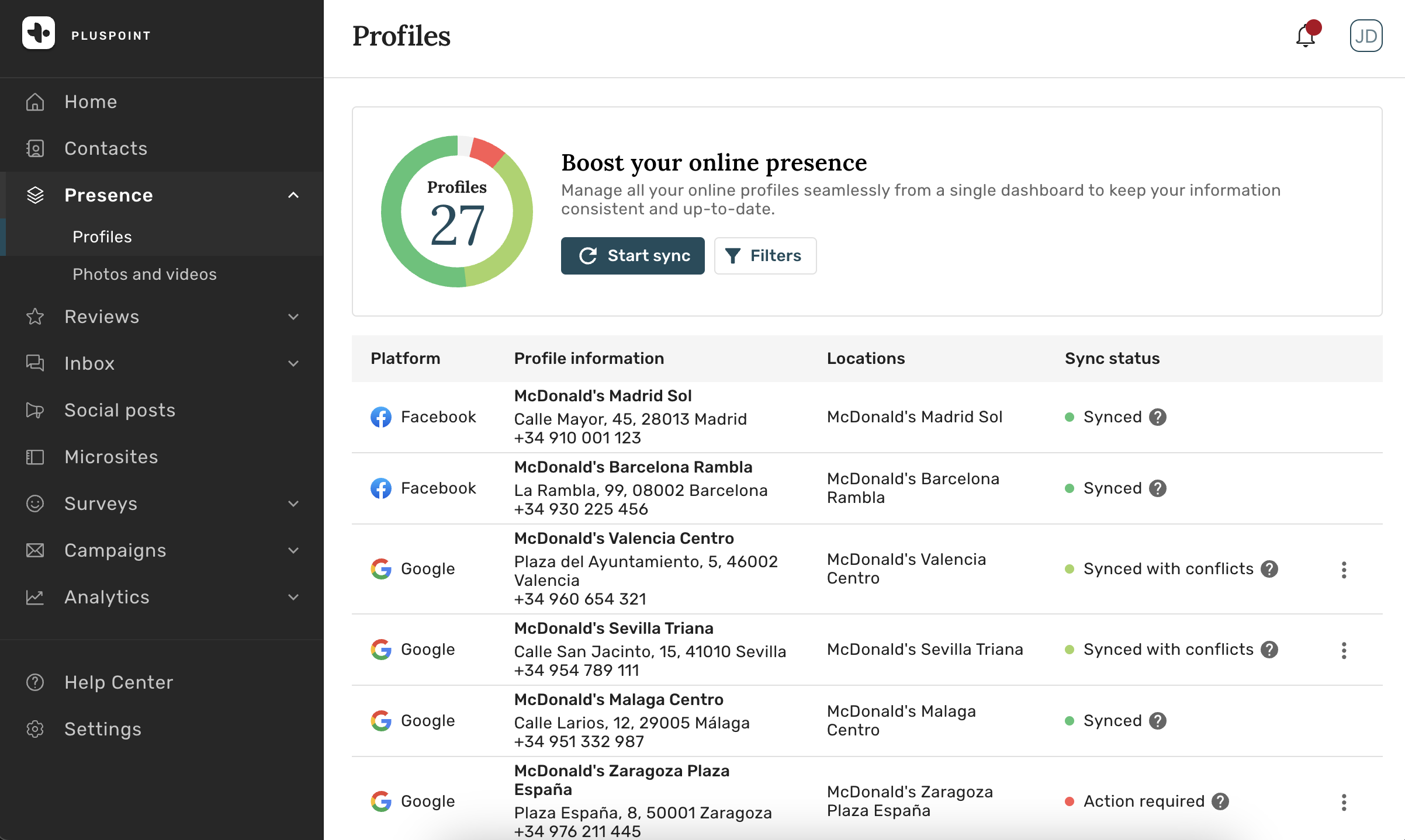
2. Review Management
Momos
Momos provides a strong, user-friendly interface for managing reviews. Restaurants can view and respond to reviews in one place, making it easier to stay on top of customer sentiment. A notable highlight is the ability to reply to negative reviews with winback forms, which can help turn dissatisfied guests into returning customers. However, the platform doesn’t support Tripadvisor reviews, which is a significant drawback for restaurants in tourist-heavy areas. While it offers AI-suggested replies, the system falls short of providing fully automated responses, leaving more manual work for teams.
Rating: ⭐⭐⭐⭐⭐ (5/5)
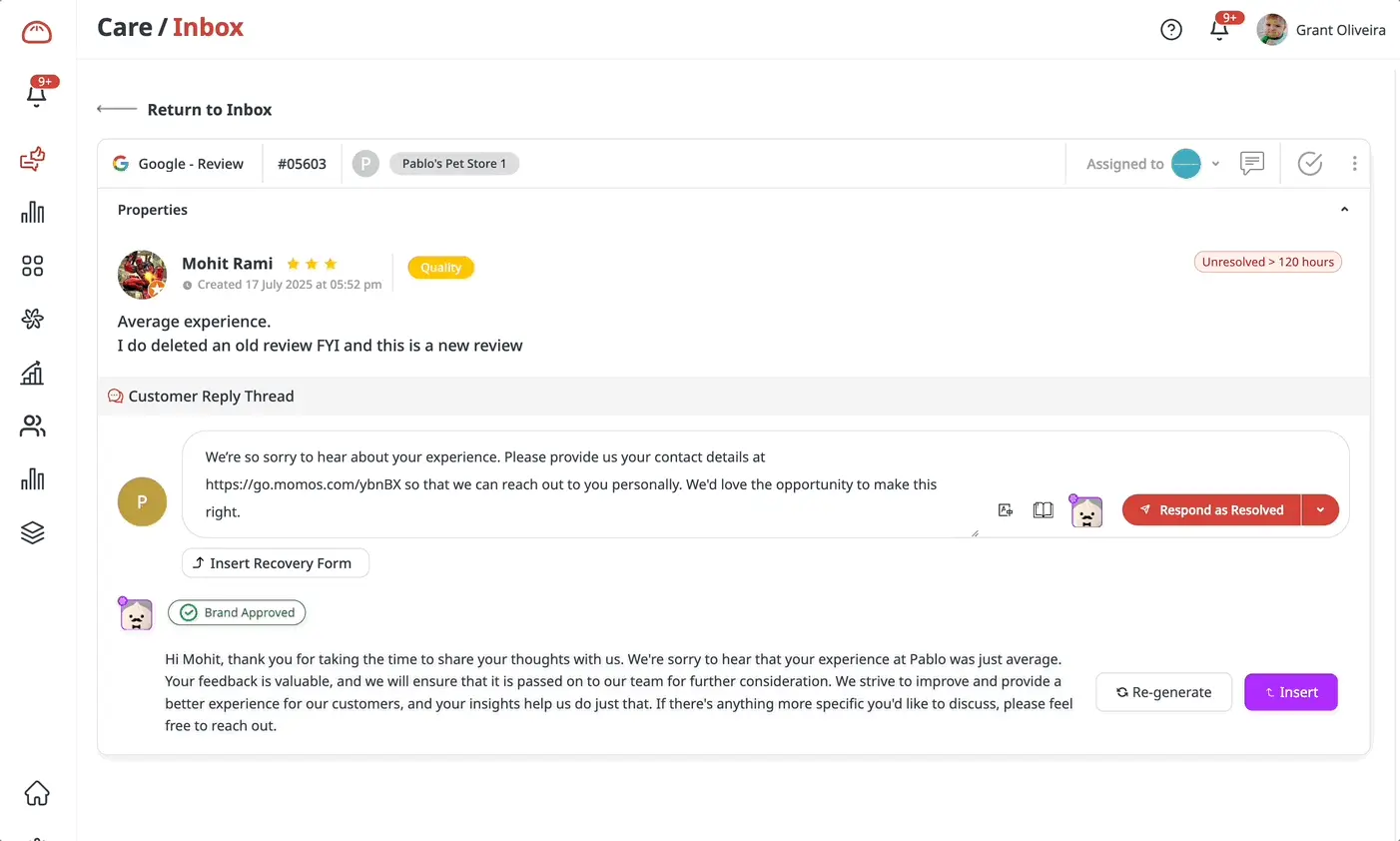
Ovation
Ovation’s review management focuses on clarity and actionable insights. Operators can monitor reviews across major platforms and benefit from a categorized view that highlights the specific areas each location needs to improve. This setup makes it easy to set and track goals tied directly to guest feedback. On the downside, AI response customization is limited, which may restrict restaurants that want more brand-consistent or nuanced replies. Still, the combination of monitoring, organization, and improvement tracking makes it a strong tool.
Rating: ⭐⭐⭐⭐⭐ (5/5)

Marqii
Marqii offers AI-generated replies with the ability to use custom prompts. However, compared to other platforms, its review management feels lighter—it lacks the ability to engage unsatisfied customers directly, which reduces its usefulness as a customer recovery tool. It simplifies the process of responding, but lacks the deeper flexibility and control that larger operators may need.
Rating: ⭐⭐⭐⭐ (4/5)
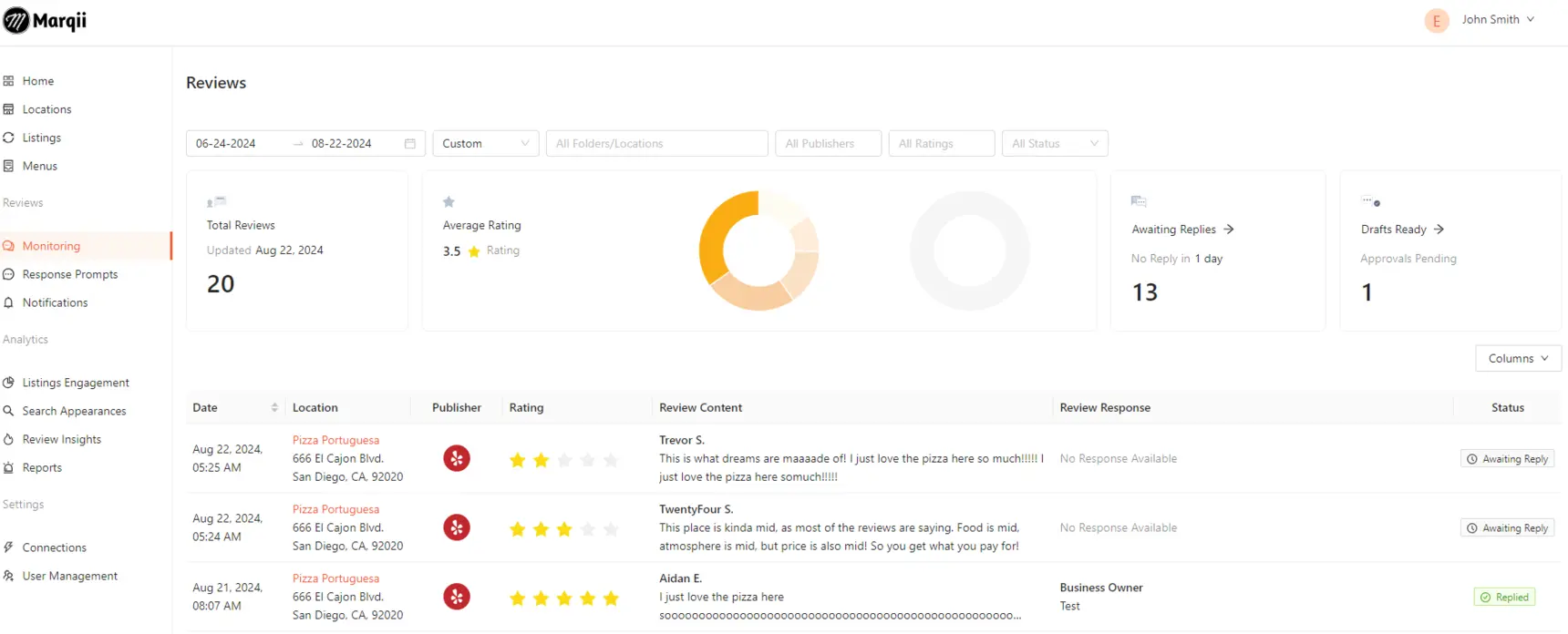
Pluspoint
Pluspoint offers an end-to-end solution for review management, integrating all major platforms into one interface. Operators can choose between suggested replies or fully automated responses powered by customizable AI, ensuring replies feel personal and consistent with brand voice. Negative reviews can trigger a winback workflow via a link that opens a direct channel with the guest, offering a chance to repair the relationship. Pluspoint also integrates semantic analysis to identify strengths and weaknesses per location, making it both a tactical and strategic tool.
Rating: ⭐⭐⭐⭐⭐ (5/5)
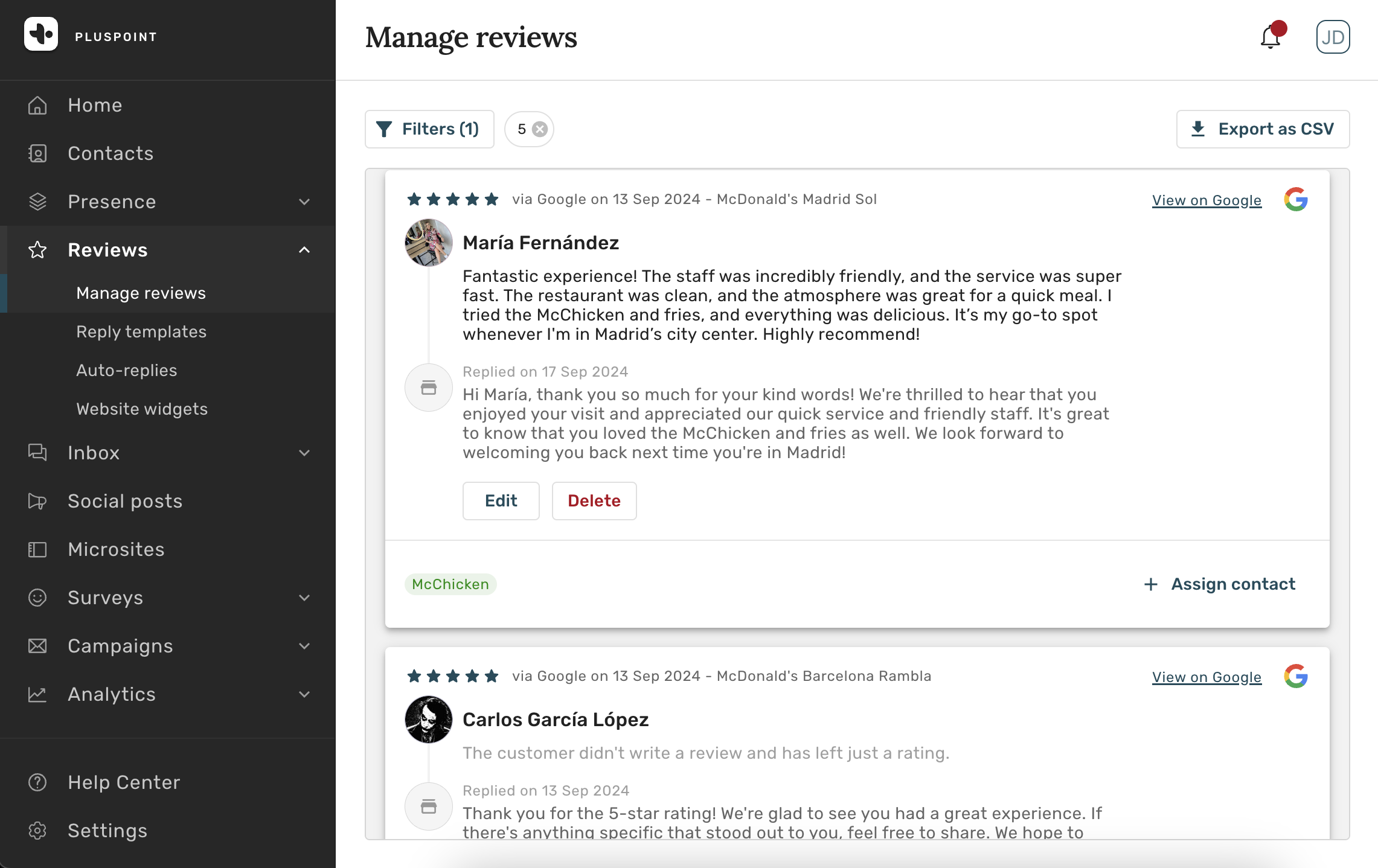
3. Social Posting
Momos
Momos does not provide social posting capabilities. While strong in other areas, it doesn’t offer restaurants the ability to publish or schedule posts on social platforms from within its system.
Rating: (0/5)
Ovation
Ovation also lacks a social posting feature. Restaurants relying on the platform would need a separate tool to manage and schedule updates across social media channels.
Rating: (0/5)
Marqii
Marqii shines here with a robust social posting module. It supports Google, Facebook, Instagram, and even Apple Showcases, giving restaurants broad coverage to manage their online visibility. The ability to centralize content distribution across these key platforms makes it a strong fit for operators looking to streamline marketing efforts.
Rating: ⭐⭐⭐⭐⭐ (5/5)
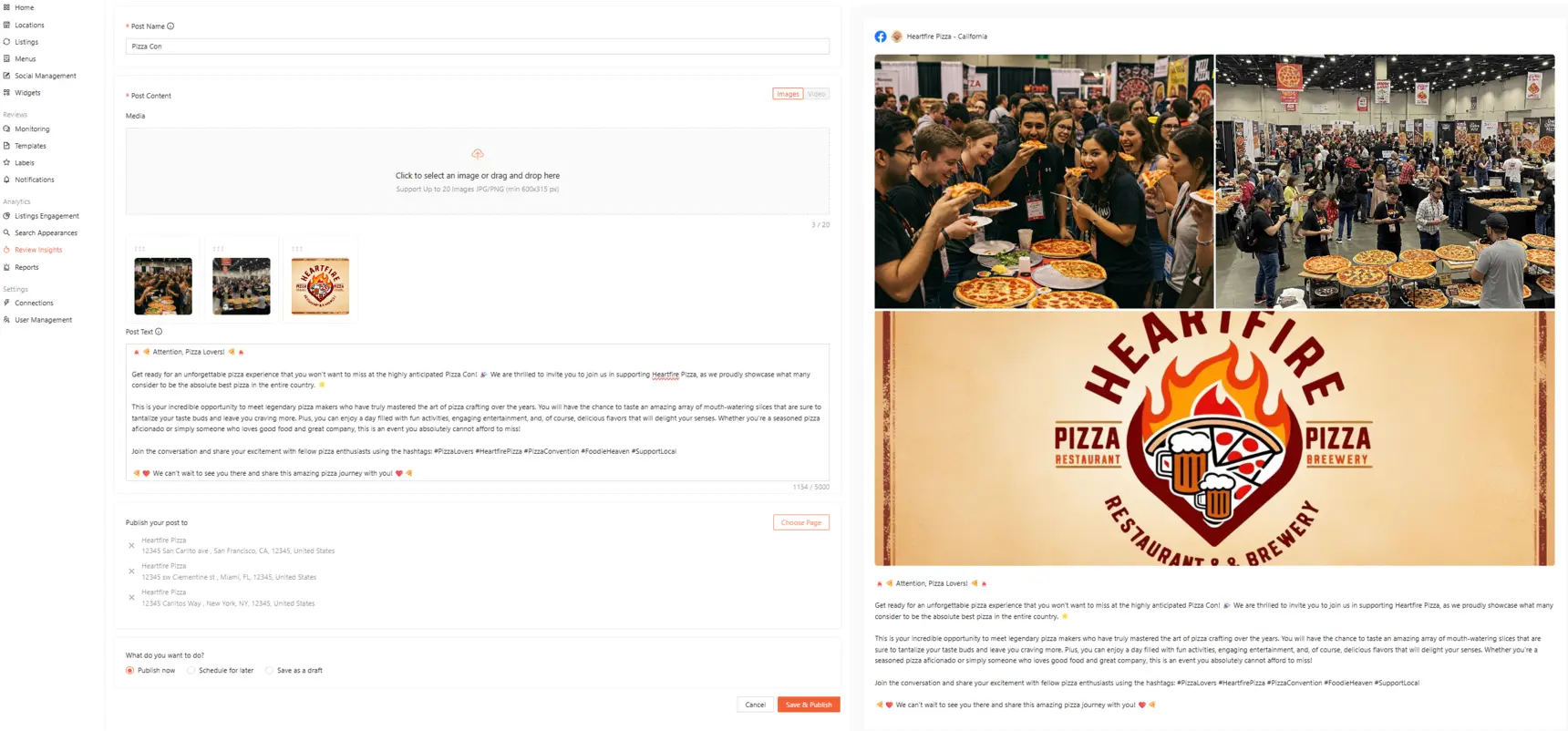
Pluspoint
Pluspoint makes social posting simple and efficient by supporting the most widely used platforms—Google, Facebook, and Instagram. Operators can post updates across all locations in one click, ensuring brand consistency and saving time for multi-location businesses. While it doesn’t extend to Apple Showcases like Marqii, its focus on centralization and ease of use is highly valuable for everyday operations.
Rating: ⭐⭐⭐⭐ (4/5)
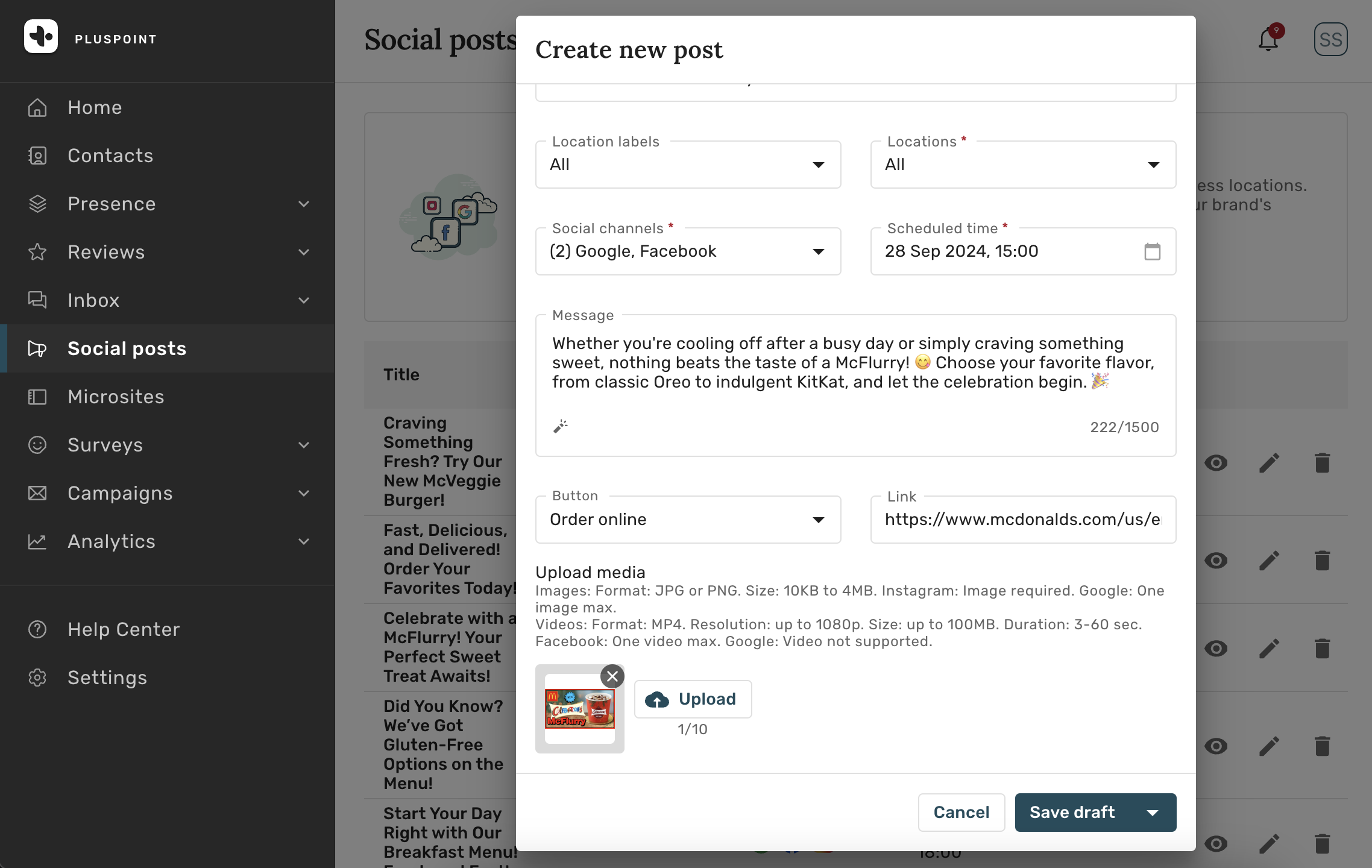
4. Customer Feedback & Surveys
Momos
Momos sets the bar high with its survey functionality, offering a wide range of customization options. Restaurants can tailor surveys with custom categories and questions, evaluate staff performance, and even reward survey completions with coupons. Negative comments can trigger winback forms to proactively address issues. Distribution channels include QR codes and email, while SMS is available but limited to the US—a drawback for international operators. The depth of features also comes with a learning curve, which may feel overwhelming for smaller teams.
Rating: ⭐⭐⭐⭐⭐ (5/5)
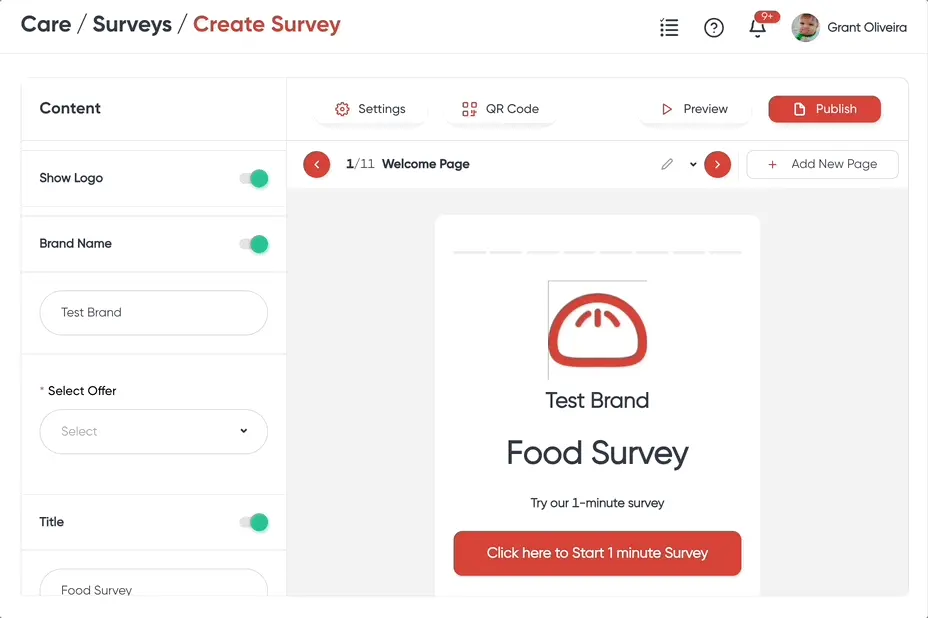
Ovation
Ovation takes a much leaner approach. By default, surveys are simple and focused on just two questions, keeping guest feedback quick and frictionless. While more questions can be added with a paid upgrade, customization of appearance is limited. Distribution relies on QR codes and SMS, which restricts use to the US market. It’s an effective solution for simplicity, but less flexible for operators seeking deeper insights.
Rating: ⭐⭐⭐⭐ (4/5)
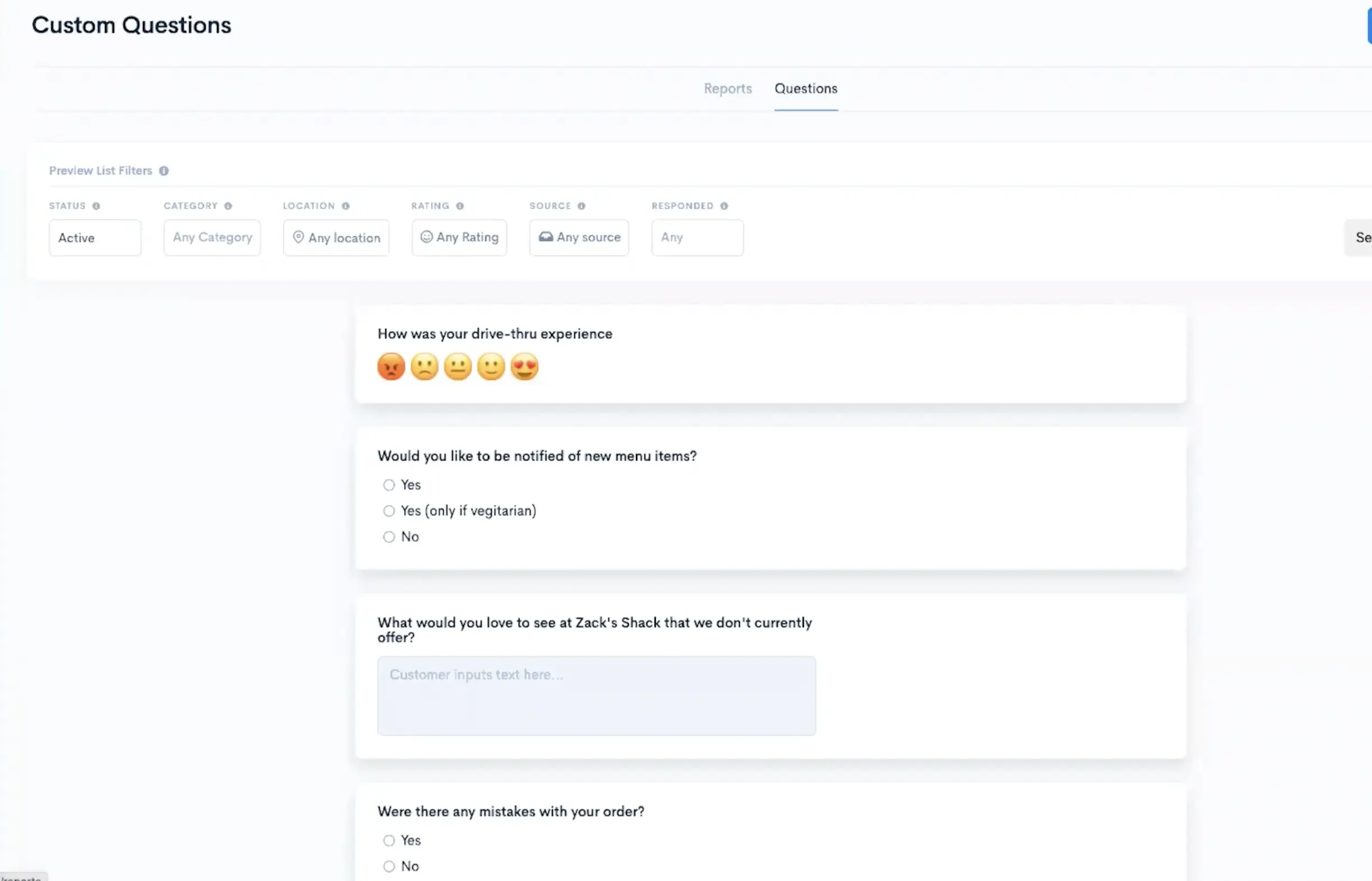
Marqii
Surveys are a missing piece in Marqii’s toolkit. The platform does not offer a feedback or survey module, leaving restaurants to rely on third-party tools if they want to collect structured customer insights.
Rating: (0/5)
Pluspoint
Pluspoint delivers one of the most sophisticated survey solutions available. It supports the widest range of channels, including WhatsApp alongside SMS and email, which makes it globally relevant. Complaints can be escalated immediately through direct contact with customers, while automated workflows allow operators to issue coupons for positive feedback or send winback links for negative comments. An additional edge comes from its AI, which can identify when a survey participant later leaves a review, providing a seamless feedback loop.
Rating: ⭐⭐⭐⭐⭐ (5/5)
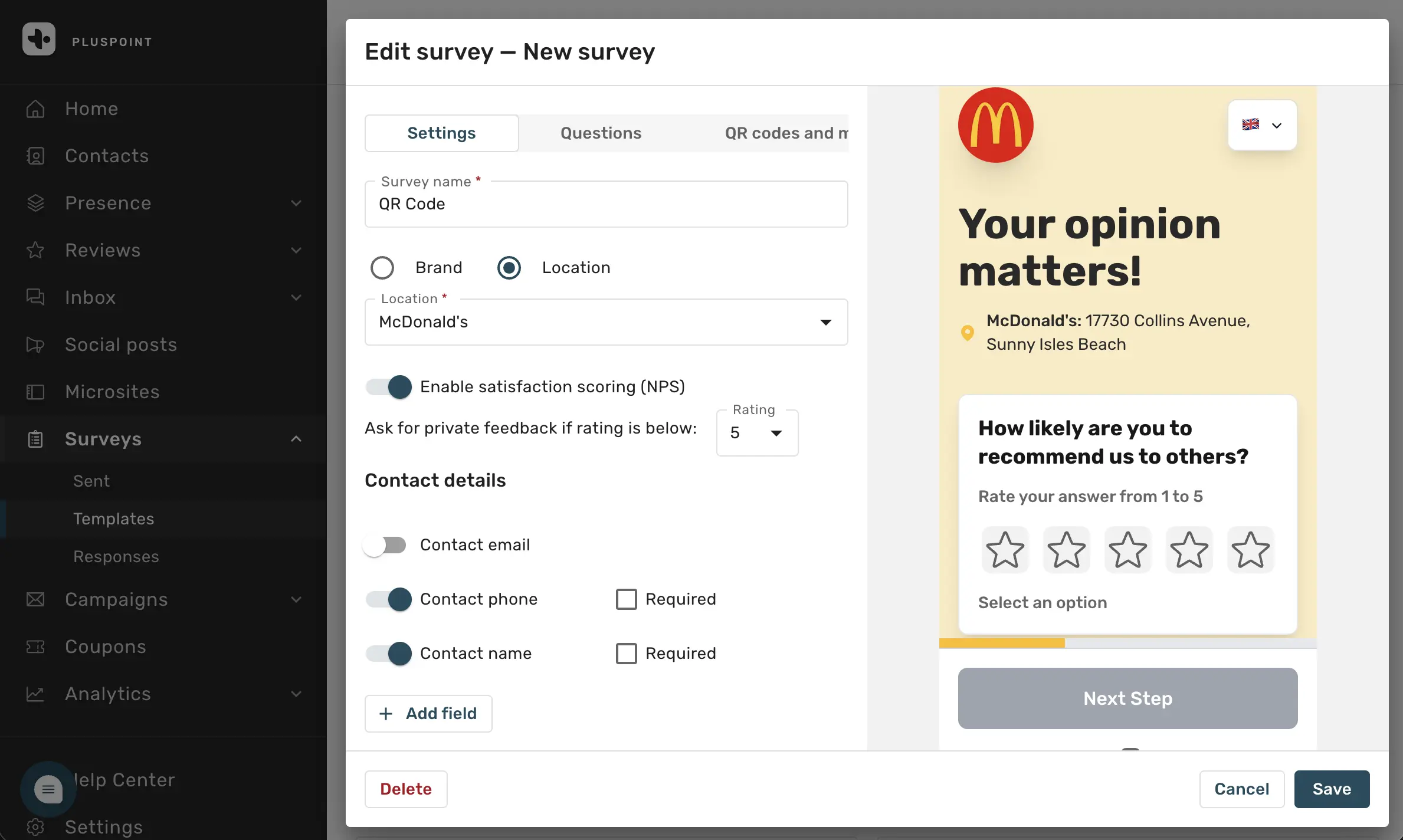
5. Inbox & Messaging Features
Momos
Momos includes an inbox for Facebook and Instagram messages, but the tool is designed mainly as an extension of its feedback system rather than a full messaging hub. As a result, it lacks critical features like response time tracking, conversation assignments, and detailed analytics. While it has introduced an AI chatbot, customization is minimal and mostly restricted to sharing links to micro-sites or external resources. For most operators, this means another tool would still be required to properly manage customer communications.
Rating: ⭐⭐⭐ (3/5)
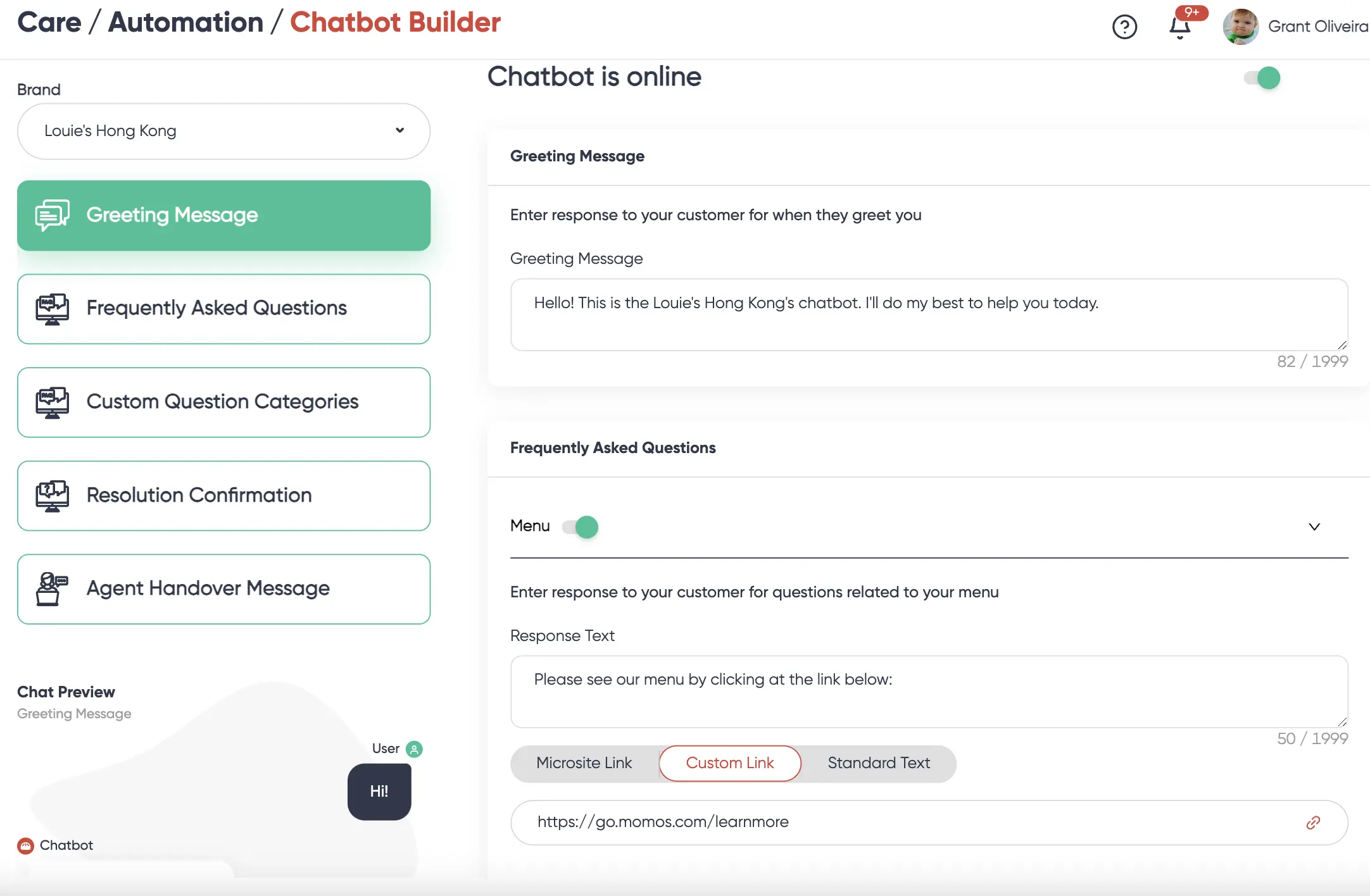
Ovation
Ovation’s messaging functionality is extremely limited. It only supports SMS, with no integration for live chat, social channels, or other messaging platforms. The simplicity keeps it straightforward, but it falls short for businesses that want to handle inquiries across multiple touchpoints. Restaurants needing structured communication and visibility will require a separate solution.
Rating: ⭐⭐ (2/5)
Marqii
Messaging isn’t part of Marqii’s offering. The platform doesn’t provide an inbox or chat solution, leaving this area entirely uncovered.
Rating: (0/5)
Pluspoint
Pluspoint offers a comprehensive inbox that supports SMS, live chat, Facebook, Instagram, and WhatsApp. Operators can create as many channels as needed and organize them flexibly, which is particularly valuable for multi-location groups. Its robust AI chatbot goes beyond simple automation, handling incoming inquiries, collecting contact details, responding with custom information, and escalating conversations to human operators when necessary. Deep analytics provide insights into performance metrics like response times, resolution rates, and individual agent productivity.
Rating: ⭐⭐⭐⭐⭐ (5/5)
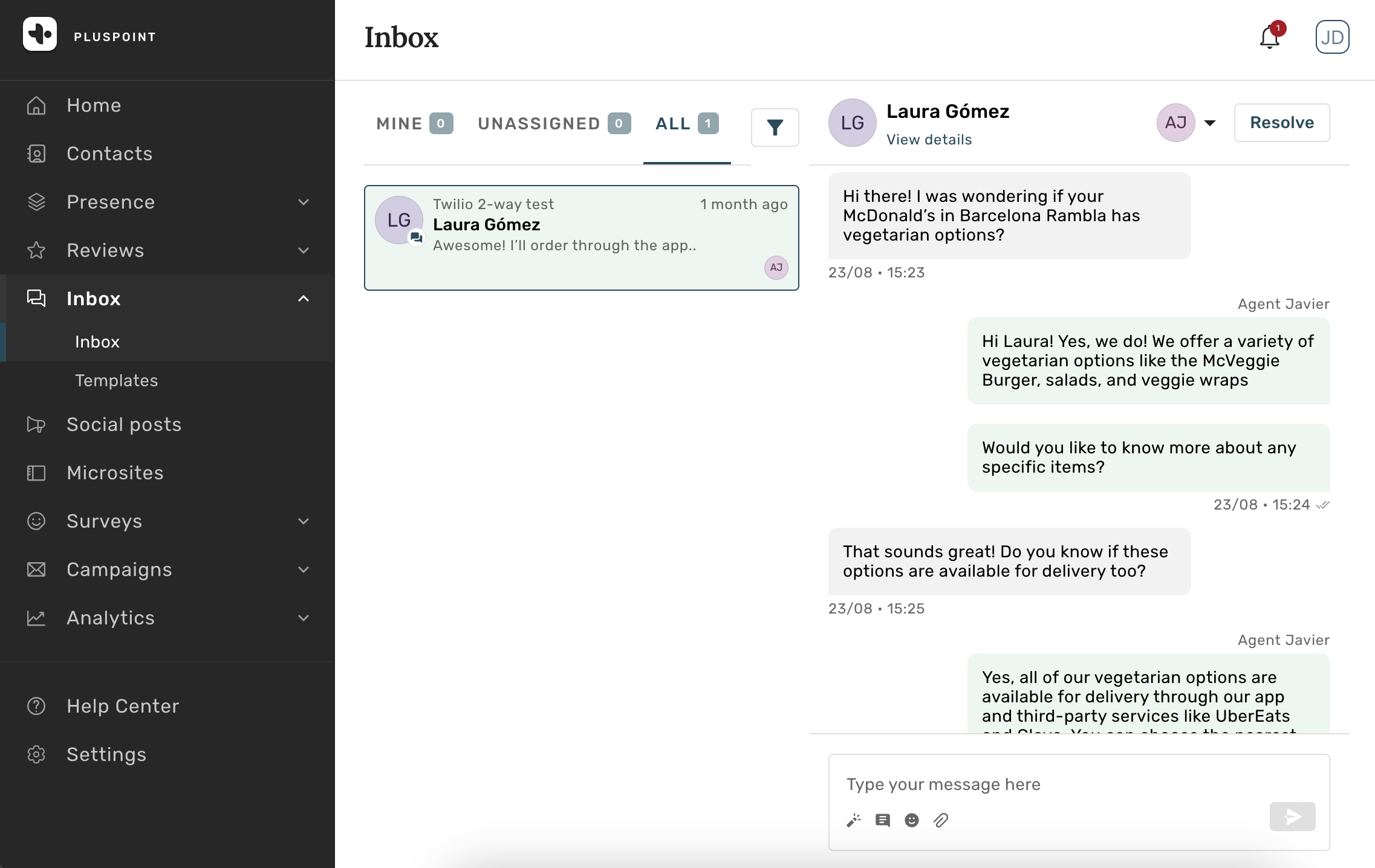
6. Campaigns
Momos
Momos provides a solid campaign feature set. Restaurants can run both one-time campaigns and automated campaigns based on triggers. Its email customization options are robust, allowing for detailed branding and personalization. SMS support, however, is limited to the US, which reduces its global utility. Campaigns can include offers such as discounts or free items, and the platform even has a “lucky draw” feature to randomly select winners—an engaging tool for customer promotions.
Rating: ⭐⭐⭐⭐ (4/5)
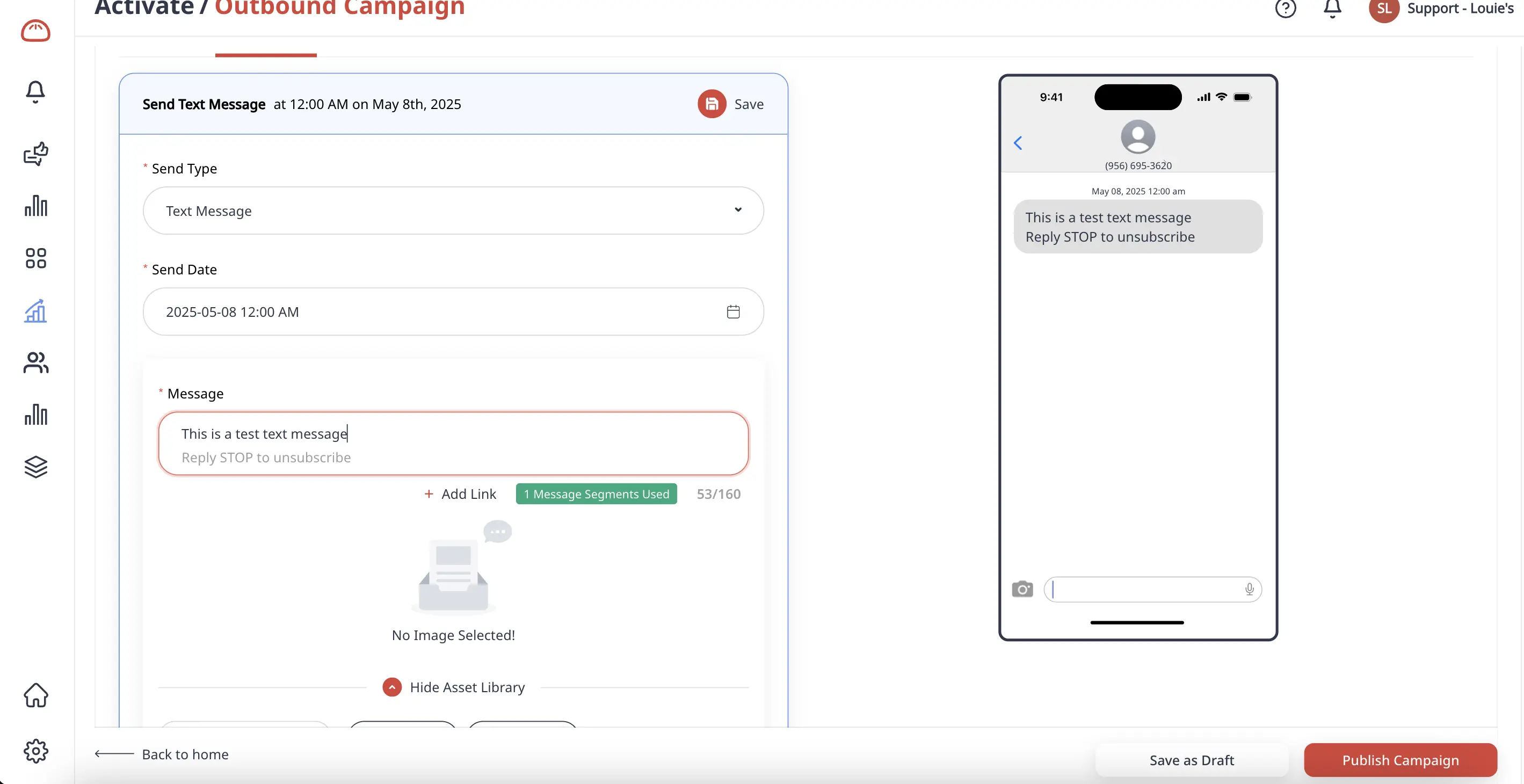
Ovation
Ovation’s campaign capabilities are focused exclusively on SMS. Operators can send blast messages or set up triggered automations, but the lack of additional channels limits reach. It’s a straightforward option for businesses primarily serving US-based customers who rely heavily on SMS, but less compelling for multi-channel or international needs.
Rating: ⭐⭐⭐ (3/5)
Marqii
Campaigns are not supported in Marqii’s platform. This absence makes it less suitable for operators looking to actively engage customers with promotions or automated messaging workflows.
Rating: (0/5)
Pluspoint
Pluspoint delivers a comprehensive campaign engine that supports both automated, trigger-based flows and one-off campaigns targeting specific customer segments. Content options are diverse, ranging from news updates and offers with coupons to surveys. With support for SMS, email, and WhatsApp, Pluspoint offers broad channel coverage that drives higher engagement. Additionally, customer responses can be managed by the AI chatbot, ensuring quick replies and seamless two-way communication.
Rating: ⭐⭐⭐⭐⭐ (5/5)
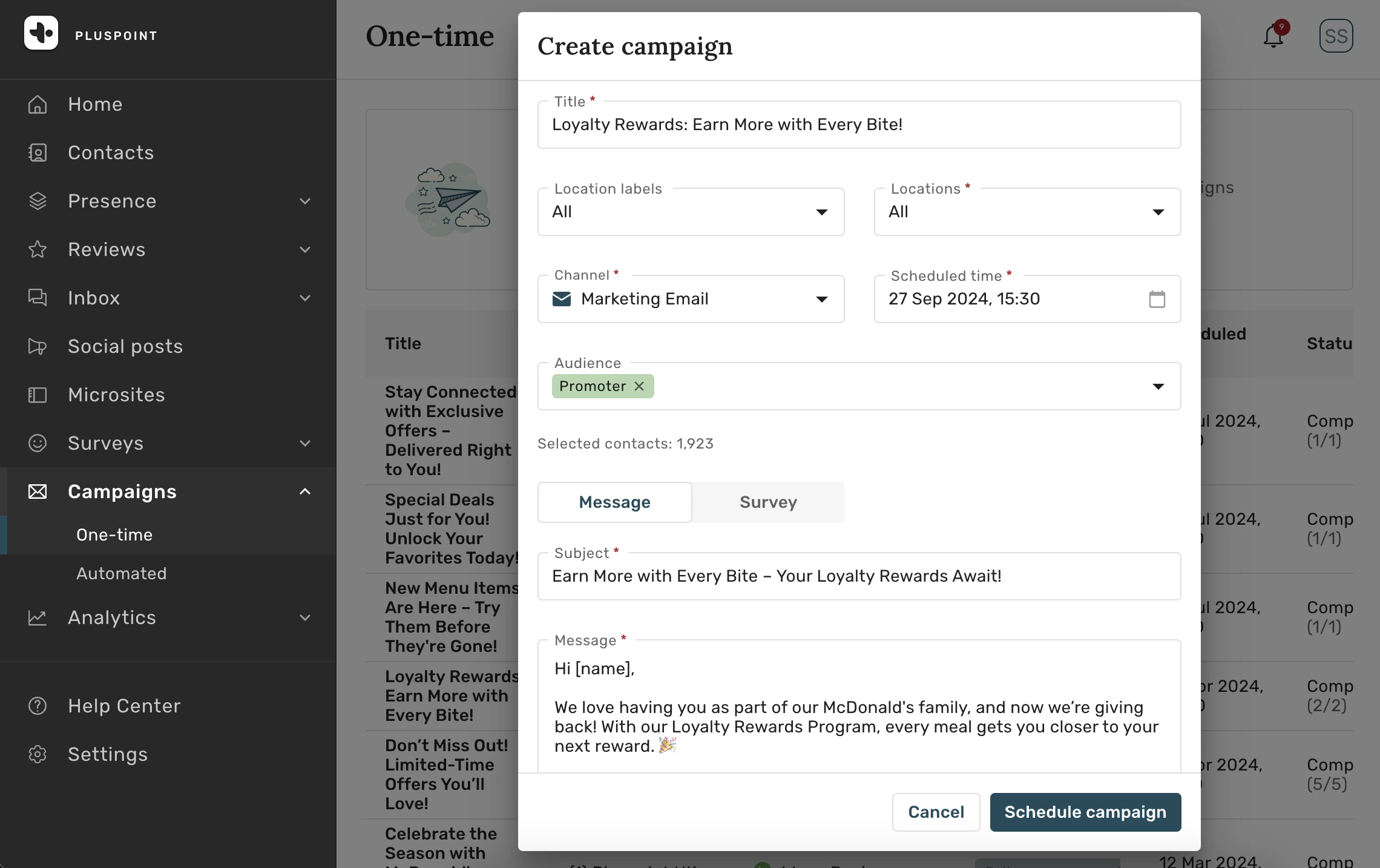
7. Pricing
Momos
Momos positions itself at the higher end of the market. A single-location restaurant pays $299/month, while multi-unit brands get a lower per-location price at $149.99/month. This pricing reflects its depth in surveys and campaigns but may be hard to justify for operators who don’t fully leverage those advanced features.
Rating: ⭐⭐⭐ (3/5)
Ovation
Ovation offers a lower entry point at $79/month per location, making it appealing to small operators. However, costs climb quickly as restaurants add essential features like review responses and insights, with pricing reaching $259/month. This tiered structure makes it affordable at first but potentially expensive for businesses scaling functionality.
Rating: ⭐⭐ (2/5)
Marqii
Marqii’s entry pricing is similar to Ovation, beginning at $74.99/month per location. Its high-tier package, which includes AI responses and social posting, costs $149.99/month. However, businesses that need engagement tools like campaigns will require additional third-party solutions, increasing overall cost of ownership. This makes Marqii appear balanced at first glance, but less so for operators seeking an all-in-one option.
Rating: ⭐⭐⭐ (3/5)
Pluspoint
Pluspoint is the most affordable among the major platforms. For $39/month, restaurants get strong online presence management, while the all-in-one engagement plan at $69/month per location includes reviews, messaging, campaigns, and more. Its transparent, accessible pricing makes it particularly attractive for multi-location brands looking for full-suite functionality without breaking budgets.
Rating: ⭐⭐⭐⭐⭐ (5/5)
Feature Comparison Table: Momos x Ovation x Marqii x Pluspoint
Which Guest Experience Platform Is Right for Your Restaurant?
Selecting the right guest experience platform depends on your restaurant’s needs. Single locations may prioritize affordability and simplicity, while multi-location brands need scalable tools—centralized listings, consistent reviews and social posting, and a unified inbox.
The real advantage comes from consolidation. Managing presence, engagement, and communication in one platform reduces costs, streamlines operations, and ensures every guest touchpoint is consistent and measurable.
The best solutions balance online visibility with guest engagement and seamless communication. Pluspoint brings it all together—helping restaurants grow smarter and faster. Ready to see how? Discover Pluspoint today.






